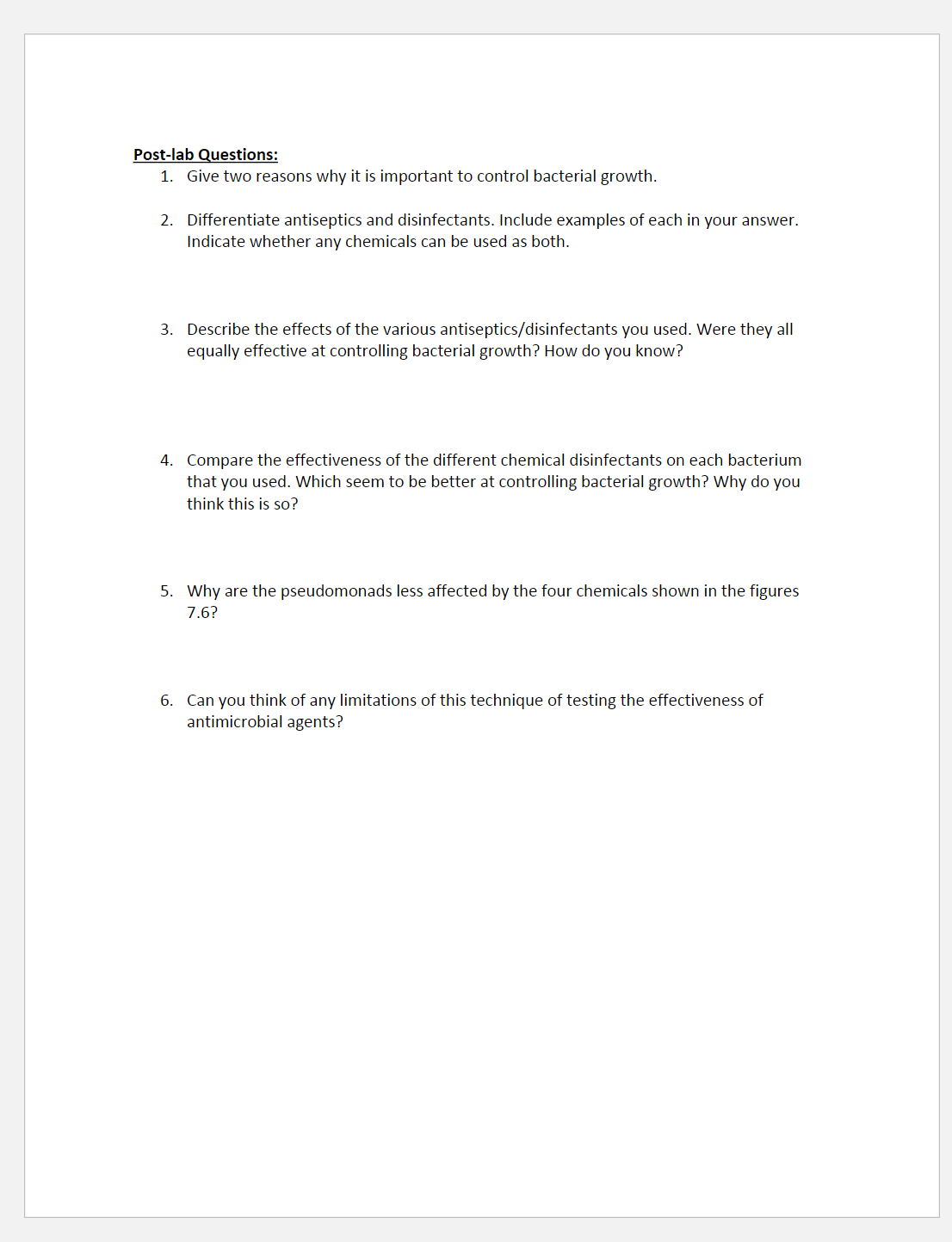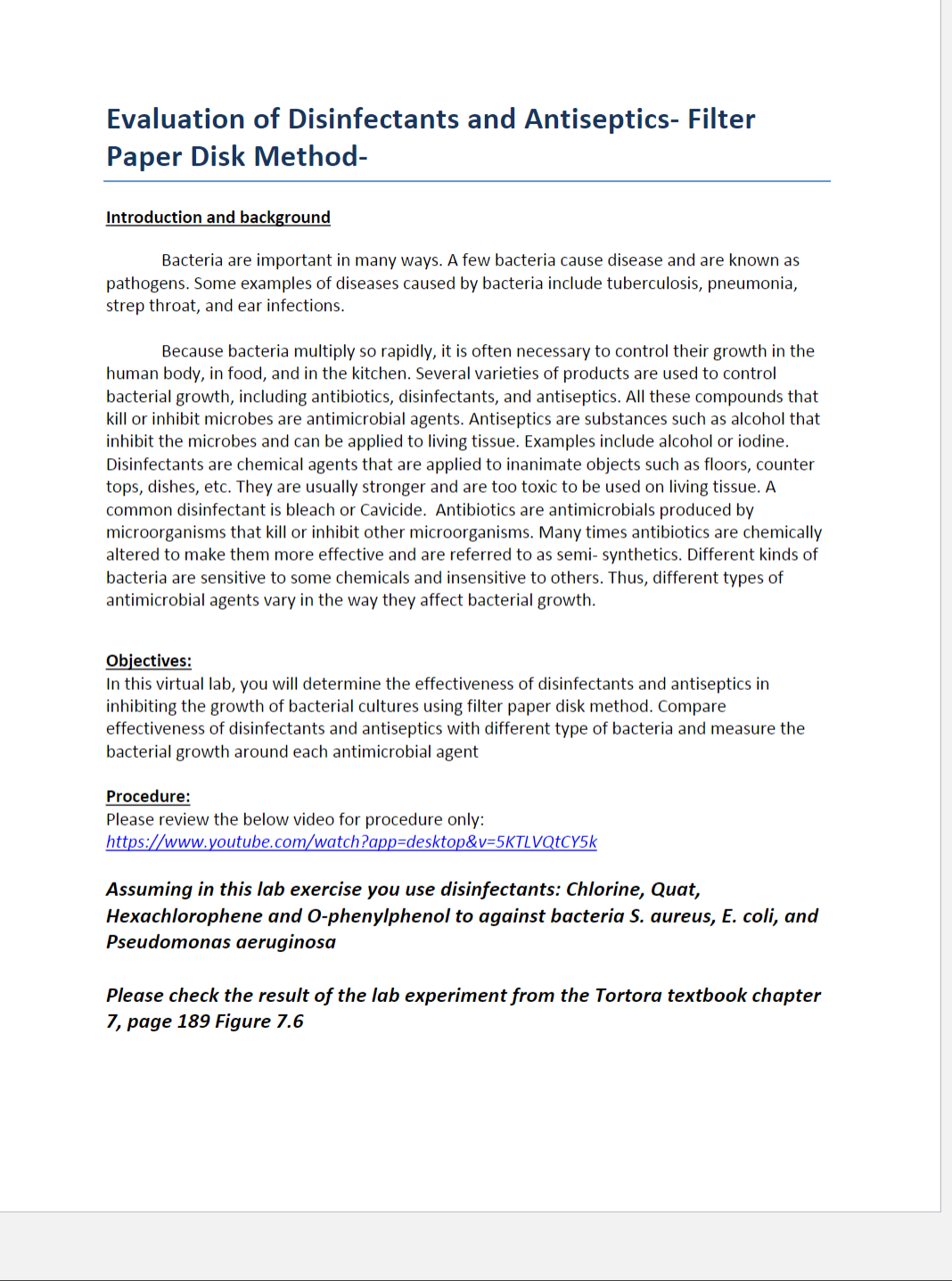Post-lab Questions: 1. Give two reasons why it is important to control bacterial growth. 2. Differentiate antiseptics and disinfectants. Include examples of each in your answer. Indicate whether any chemicals can be used as both. 3. Describe the effects of the various antiseptics/disinfectants you used. Were they all equally effective at controlling bacterial growth? How do you know?
Post-lab Questions: 1. Give two reasons why it is important to control bacterial growth. 2. Differentiate antiseptics and disinfectants. Include examples of each in your answer. Indicate whether any chemicals can be used as both. 3. Describe the effects of the various antiseptics/disinfectants you used. Were they all equally effective at controlling bacterial growth? How do you know?
Biology 2e
2nd Edition
ISBN:9781947172517
Author:Matthew Douglas, Jung Choi, Mary Ann Clark
Publisher:Matthew Douglas, Jung Choi, Mary Ann Clark
Chapter22: Prokaryotes: Bacteria And Archaea
Section: Chapter Questions
Problem 22RQ: Which of the statements about biofilms is incorrect? Biofilms are considered responsible for...
Related questions
Question
Evalutation of Antiseptics/Disinfectants - Filter Paper Disk Method

Transcribed Image Text:Post-lab Questions:
1. Give two reasons why it is important to control bacterial growth.
2. Differentiate antiseptics and disinfectants. Include examples of each in your answer.
Indicate whether any chemicals can be used as both.
3. Describe the effects of the various antiseptics/disinfectants you used. Were they all
equally effective at controlling bacterial growth? How do you know?
4. Compare the effectiveness of the different chemical disinfectants on each bacterium
that you used. Which seem to be better at controlling bacterial growth? Why do you
think this is so?
5. Why are the pseudomonads less affected by the four chemicals shown in the figures
7.6?
6. Can you think of any limitations of this technique of testing the effectiveness of
antimicrobial agents?

Transcribed Image Text:Evaluation of Disinfectants and Antiseptics- Filter
Paper Disk Method-
Introduction and background
Bacteria are important in many ways. A few bacteria cause disease and are known as
pathogens. Some examples of diseases caused by bacteria include tuberculosis, pneumonia,
strep throat, and ear infections.
Because bacteria multiply so rapidly, it is often necessary to control their growth in the
human body, in food, and in the kitchen. Several varieties of products are used to control
bacterial growth, including antibiotics, disinfectants, and antiseptics. All these compounds that
kill or inhibit microbes are antimicrobial agents. Antiseptics are substances such as alcohol that
inhibit the microbes and can be applied to living tissue. Examples include alcohol or iodine.
Disinfectants are chemical agents that are applied to inanimate objects such as floors, counter
tops, dishes, etc. They are usually stronger and are too toxic to be used on living tissue. A
common disinfectant is bleach or Cavicide. Antibiotics are antimicrobials produced by
microorganisms that kill or inhibit other microorganisms. Many times antibiotics are chemically
altered to make them more effective and are referred to as semi- synthetics. Different kinds of
bacteria are sensitive to some chemicals and insensitive to others. Thus, different types of
antimicrobial agents vary in the way they affect bacterial growth.
Objectives:
In this virtual lab, you will determine the effectiveness of disinfectants and antiseptics in
inhibiting the growth of bacterial cultures using filter paper disk method. Compare
effectiveness of disinfectants and antiseptics with different type of bacteria and measure the
bacterial growth around each antimicrobial agent
Procedure:
Please review the below video for procedure only:
https://www.youtube.com/watch?app=Ddesktop&v=5KTLVQTCY5K
Assuming in this lab exercise you use disinfectants: Chlorine, Quat,
Hexachlorophene and O-phenylphenol to against bacteria S. aureus, E. coli, and
Pseudomonas aeruginosa
Please check the result of the lab experiment from the Tortora textbook chapter
7, page 189 Figure 7.6
Expert Solution
This question has been solved!
Explore an expertly crafted, step-by-step solution for a thorough understanding of key concepts.
This is a popular solution!
Trending now
This is a popular solution!
Step by step
Solved in 2 steps

Recommended textbooks for you

Biology 2e
Biology
ISBN:
9781947172517
Author:
Matthew Douglas, Jung Choi, Mary Ann Clark
Publisher:
OpenStax

Biology 2e
Biology
ISBN:
9781947172517
Author:
Matthew Douglas, Jung Choi, Mary Ann Clark
Publisher:
OpenStax